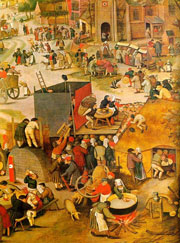
01 02 03 References
In the enlightenment conception, what does the public sphere allow us to do? Damiris and Wild, in their paper "The Internet: A New Agora?" have perceptively and usefully described different modes of public behavior: rational action, social action and ethical action. We could gain another perspective on the public space by turning sideways and examining it as a domain of synchronicity, speech-action and commitment. In any event, we nuance the notion of public by distinguishing community from society, where society is not simply a union or a web of black-box communities but a vibratory medium in which communities can absorb influences and find dis/harmonics with distant communities. It is the rich confusion of our physical world, together with the instability of the virtual one, that allows hybrid public spaces to emerge.
After a long period of individualization, people are urgently forming bonds across the globe, and these bonds need a lot of room to grow. The debate about what constitutes public space and the activities that evolve in them is not new. Every society infected by the notion of the Greek polis has its own ambivalent relationship with this concept of public space.
On one hand, public space is necessary to mediate a community, on the other, it has a great subversive power. Historically, public spaces were not only a home to sellers, buyers and news-broadcasters, but also to alternatives, radicals, thieves and jesters. Building a public space is a project in which the whole community contributes to build a place where both personal and public memories can be stored and reused, a place that ties society together in rituals and common goals.
3 Historical Alternatives
What examples from history can we draw on for alternative ways of being public, of public performance? The well known examples are:
- Agora, classical basis for western democratic polis;
- Pre-capitalist Market, base of an exchange economy between different communities;
- Renaissance Italian Piazza, meeting place where most of the everyday life took place;
- Garden, place for reconciliation, meditation and interaction with people and nature;
- Street used not as a transport conduit, but as a locus of experiencing a city in time;
- Fair or Festival, itinerant public event that adapts to different local conditions;
- Mediaeval Circus, parade of tolerated differences;
- Situationists' psychogeographic experiments and playful approaches to urbanism;
We pay attention to aspects of these public spaces, that could inform our approach to hybrid or augmented spaces. These aspects include material resistances, territory, temporality and synchronicity and ritual, commitment and empathy, the aesthetic span between logic and sensuality.
Both mentioned historical examples and public experiments that we conduct today should be fully lived interactive experiences, spaces based on the temporal rhythms of emergence and disappearance, where the experience is a synergy of an eerie ambience, smells, sounds, change and exchange, memory, prophecy and ecstatic dance. The language of the these spaces is alive and shared among its participants, not owned by anyone, but spontaneously generated by everyone, in all variety of individual argot.

Breugel. Booth Theatre and Fair
back to sponge >